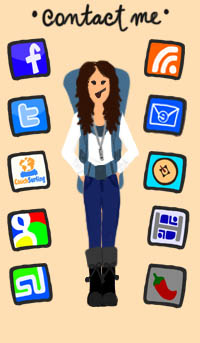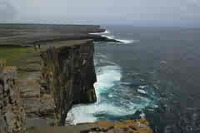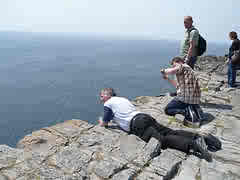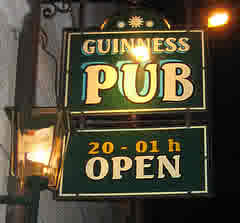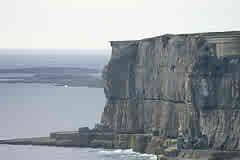The post to follow is part of a series of posts of my honest opinion of my time on Inishmore, however it should be noted that some of the expenses of this trip were waived or paid for by the Aran Island Hotel and the tourism board for the Aran Islands. Don’t hate me for taking free stuff and I promise, if I didn’t love the island, I wouldn’t write nice things about it.
For St. Patrick’s Day this year, I was asked to write an article for BootsnAll on how the Irish language is still alive and flourishing. I begin by mentioning that when I first came to Ireland over 2 years ago, I did not know that there was such a thing as the “Irish” language. Rather, upon initial descent into Ireland, I thought that Irish was just a sort of thick accent with its own lingo and dialect (like Ebonics or Jamaican). After spending a couple of months in Galway (in Irish Galliamh pronounced GAHL-yiev), I’ve been able to spend some time really diving into the culture and history of the language as well as learn a bit myself.
 If you want the full history and lesson of Irish, read my article here on BootsnAll. For those with limited attention spans, Irish (in Irish Gaeilge pronounced GAYLE-guh), has been spoken on the Emerald Isle since 1200 BC. During British rule in Ireland, most spoken Irish was banned or pushed to the far west of the island (hence why the highest concentration of Irish speakers is in the West). After the Republic of Ireland gained its independence in 1922, the language was slowly reintegrated into the everyday life of those living in the country. Most street signs and road signs are in both English and Gaeilge; sometimes only Gaeilge in areas known as the Gaeltacht (Gahl-TAHCHT) which are those areas where Gaeilge is still the primary language. Children are now required to learn Irish in school and some schools are taught exclusively in Irish. Needless to say, the Irish language is beginning to become a larger part of everyday life for those living there. One of the best places in the world to hear spoken Irish is on the Aran Islands.
If you want the full history and lesson of Irish, read my article here on BootsnAll. For those with limited attention spans, Irish (in Irish Gaeilge pronounced GAYLE-guh), has been spoken on the Emerald Isle since 1200 BC. During British rule in Ireland, most spoken Irish was banned or pushed to the far west of the island (hence why the highest concentration of Irish speakers is in the West). After the Republic of Ireland gained its independence in 1922, the language was slowly reintegrated into the everyday life of those living in the country. Most street signs and road signs are in both English and Gaeilge; sometimes only Gaeilge in areas known as the Gaeltacht (Gahl-TAHCHT) which are those areas where Gaeilge is still the primary language. Children are now required to learn Irish in school and some schools are taught exclusively in Irish. Needless to say, the Irish language is beginning to become a larger part of everyday life for those living there. One of the best places in the world to hear spoken Irish is on the Aran Islands.
The Aran islands are a string of three islands located at the mouth of Galway Bay in County Galway in western Ireland. The three islands have gone through an extensive history of renaming and ownership and so some people call them different things (I’ve seen Inishmore spelled Árainn, Inis Mór and Inishmore), but the accepted names for these islands are Inishmore (pronounced in-nish-MORE), Inishmaan (pronounced in-nish-MAHN) and Inisheer (pronounced in-nish-SHEER). The islands are all VERY small (the largest being just 12 square miles) and the in total only claims 400 permanent residents.
To get to the islands requires planning. There are a limited number of beds on the island (only 200, last I heard) with one hotel, one hostel and only a handful of bed and breakfasts. There are only two ways to get there; either fly (via Aer Arann Islands from Connemara Regional Airport west of Galway City to the airport on Inishmore) or take one of the daily ferries that leave from Ros a’ Mhíl or Doolin and go to the islands (you can buy a shuttle through the same company to Ros a’ Mhíl from Galway City).
Once there, it is not difficult to hear  by Keith Williamson Irish being spoken. For the easy route, turn on the television in your room. The main television station broadcast on the islands is in Irish, and trust me, you’ll know it when you hear it. When I arrived on Inishmore, it was lunch time and as such, I headed straight for the pub. I casually listened as the dozen or so old men around me chatted gleefully in what I will call Engrish (a mix of English and Irish) but most of what they said was in Irish. The men sat and talked about man things, I presume as an Irish football (and no, that is NOT the same thing as soccer) game played (in Irish) on the television behind them. The bar I was at was called the American Bar so the walls were littered with posters of JFK, Joe DiMaggio, Mickey Mantle, Marilyn and a wall collaged with police patches from various US cities (which I’ve found is quite a common decoration for “American” bars in Ireland). But this place was far from American.
by Keith Williamson Irish being spoken. For the easy route, turn on the television in your room. The main television station broadcast on the islands is in Irish, and trust me, you’ll know it when you hear it. When I arrived on Inishmore, it was lunch time and as such, I headed straight for the pub. I casually listened as the dozen or so old men around me chatted gleefully in what I will call Engrish (a mix of English and Irish) but most of what they said was in Irish. The men sat and talked about man things, I presume as an Irish football (and no, that is NOT the same thing as soccer) game played (in Irish) on the television behind them. The bar I was at was called the American Bar so the walls were littered with posters of JFK, Joe DiMaggio, Mickey Mantle, Marilyn and a wall collaged with police patches from various US cities (which I’ve found is quite a common decoration for “American” bars in Ireland). But this place was far from American.
As I sat there listening to the men chat, I couldn’t help but wonder why I never knew that this language exists. As Americans, we’re pretty obsessed with all things Irish; whether it be the men, the accent, the heavy drinking culture. We love to associate ourselves with Ireland and most of us find any excuse to say we’re Irish (my sister has reddish hair, so that MUST mean there’s Irish in my blood somewhere, right?). So how does it slip through the cracks that Irish is still a big part of the culture in Ireland?
A bit of Irish to help you feel important around your friends:
Hello – Dia duit (pronounced DI-ah GWIT)
Goodbye - Slán (pronounced SLAHN)
Cheers – Sláinte (pronounced SLAYNT-chee)
Thank You – Go Raibh Maith Agat (pronounced GUH REV MAH ah-GUT)
Fun (used a lot by Engrish speakers, like “what’s up” and may or not be actual Irish, but it’s still good to know) – What’s the craic? (Pronounced CRACK)
For more on the Irish language, check these sites:
Irish Language on Wikipedia
A good beginner's guide to the Irish Language
Beginner's Irish Phrases and Pronounciation
For more on the Aran Islands, check these sites:
The Aran Island Hotel
Aran Islands on Wikipedia
Aran Islands Travel Guide
Aran Islands on Wikitravel
Aran Islands on Google Maps
 Saturday, January 29, 2011 at 10:00AM |
Saturday, January 29, 2011 at 10:00AM |  6 Comments
6 Comments 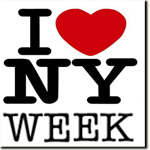 Sick of New York City posts? Well you asked for them, so I'm givin' em. Get over it already, I'll be back to talking only about Spain here in 49 days! Until then, it's either New York, or Oklahoma. And I have a feeling you're going to like the NY posts better than the Okie ones. The following restaurants are my absolute favorites in New York. I can go to them day after day and never tire. They're good for all tourists...
Sick of New York City posts? Well you asked for them, so I'm givin' em. Get over it already, I'll be back to talking only about Spain here in 49 days! Until then, it's either New York, or Oklahoma. And I have a feeling you're going to like the NY posts better than the Okie ones. The following restaurants are my absolute favorites in New York. I can go to them day after day and never tire. They're good for all tourists... New York,
New York,  New York City,
New York City,  USA,
USA,  cityguide in
cityguide in  My Trips,
My Trips,  Travel Tips
Travel Tips 
